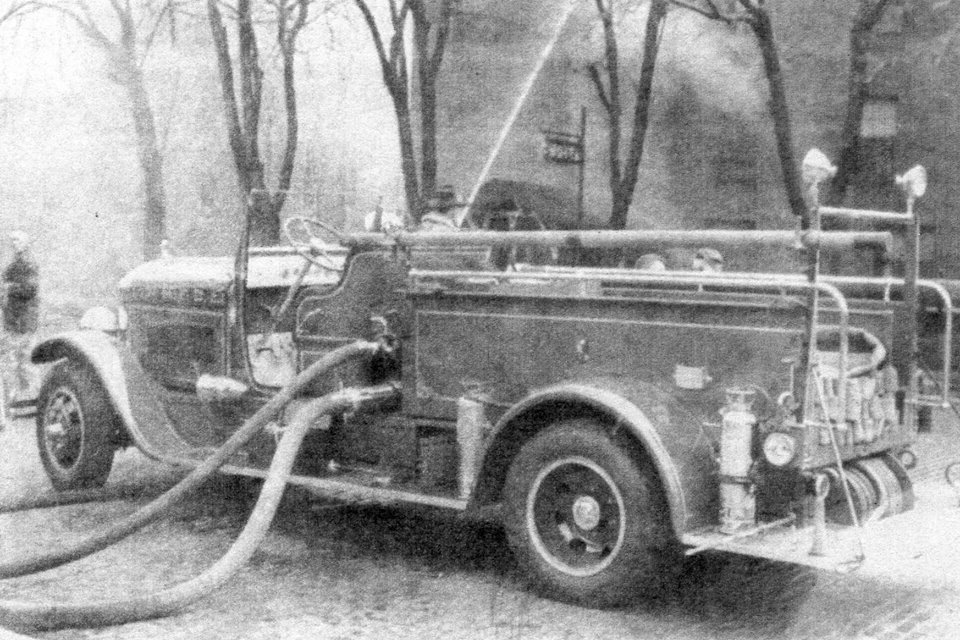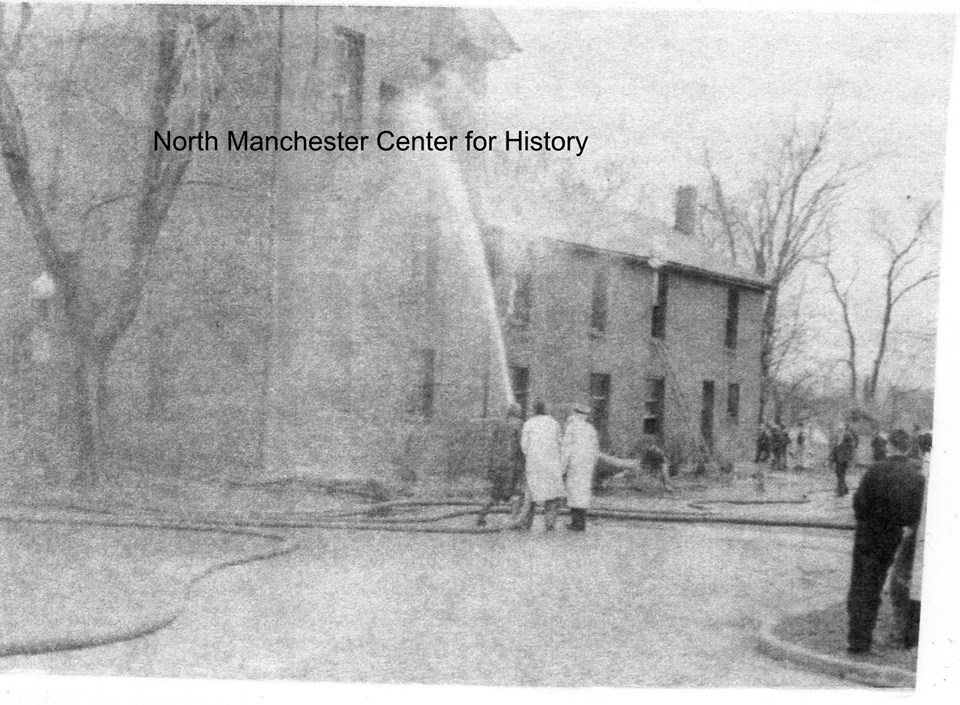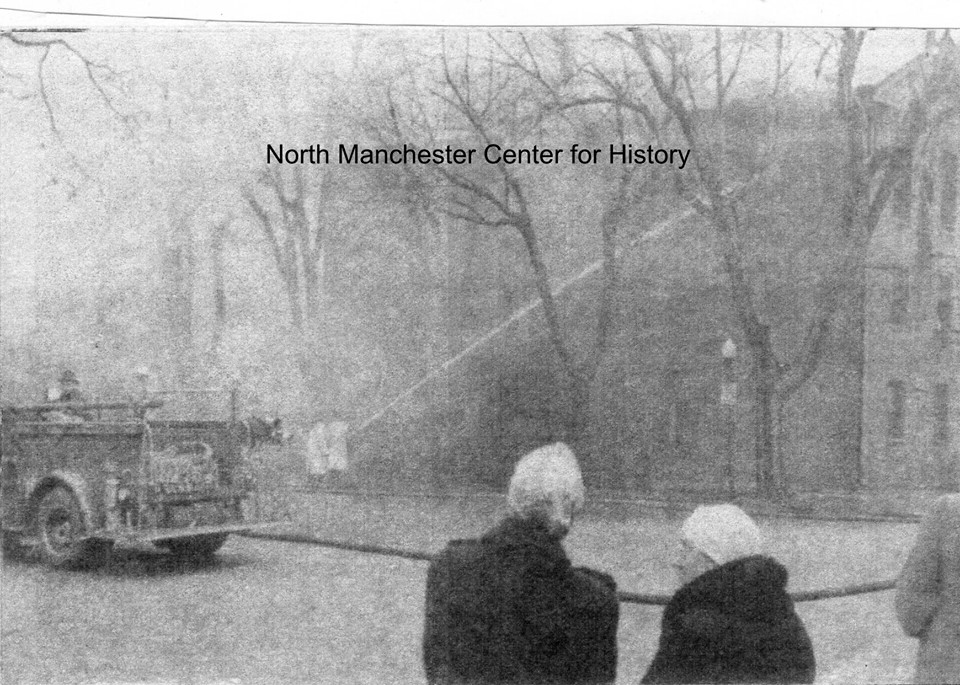
Photos of the 1943 fire that destroyed the Young Hotel--



Source: News-Journal, March 1, 1943
FIRE DESTROYS OLD TOWN LANDMARK
One of the most destructive fires in North Manchester in recent years occurred Thursday afternoon when the Young Hotel was partially destroyed. The upper part of the three story structure was burned and charred down to the second floor, and part of that was damaged, while most of the second story of the wing to the south was burned. Firemen fought the flames for over four hours before the fire was put out, and by that time the building was a wreck from fire, smoke and water. A considerable part of the hotel furnishings were salvaged, especially from the first and second floors, but much was damaged by being thrown out windows, and a considerable amount could not be reached because of smoke.
The fire really started after a first fire had been discovered and put out by Bill Weesner, taxi driver. A container filled with cleaning rags started to burn a little after twelve o'clock. The container was against a wall in a wash room directly above the furnace. It was discovered before it had made much headway, and a call to the fire department was cancelled before an alarm was sounded. The supposition is that the fire unnoticed, had burned through the plastering and reached the woodwork of the wall. There it smouldered, eating its way up the inside of the wall and was not discovered until smoke commenced to pour out of the upper part of the building. The fire reached the attic, and because of smoke and the slate roof, Firemen could not get at it directly. It was not until it burned through the roof, that streams of water could be played directly on the fire. From then on it was a battle to bring it under control. The firemen were handicapped further by the fact that the building originally was a wooden structure, to which had been added stucco, and later a brick veneer wall. Thus it could burn on the inside without burning through to the outside, where it could have been reached with water.
The fire attracted many spectators, some of whom were of assistance in removing the furnishings, and some were more or less a hindrance. No one was injured and considering the number of people who entered the building while it was burning, they were lucky to escape without being hurt. The furnishings were taken to the basement of the Lutheran church and other nearby buildings, and as soon as possible Mrs. Dunbar will sell them at auction. She had some insurance on the contents. The building is owned by John Geyer of Sebring, Florida, and was insured for $2,000. He purchased the building last summer from the Dr. George L. Shoemaker estate. The hotel was used as a bus station and Mrs. Dunbar plans to lease the room in the Tyler building formerly occupied by the Lorenz jewelry store, and use it for bus headquarters. Willard Weesner will use it also for his taxi headquarters.
The hotel was an ancient landmark in North Manchester, and many are the reminiscent stories told about it and the events that occurred within its walls.
According to best tradition it was built about or before 1857 by M.T. Siling, as a cabinet shop. Later Joel Tilman acquired the business probably about 1861 or 1862. Calvin E. Wood remembers that when he was a boy of three or four, he was in the building and saw a room full of coffins and he was so scared he ran home. That was in the days when coffins were plain wooden affairs, frequently made to order after the measurements of the person who died. They were known as coffins then and not caskets, and people were "laid out" for burial instead of using the services of an undertaker.
A man named Bone bought the building and started a hotel. Later a man named Keller purchased it and it became known as the Keller House. He operated it several years, but in 1884 Shelby Sexton bought the business and it was operated under the name of the Sexton House. Old times say a man named King operated it for a short time, and then Freeman Fox, who gave it the name of the Fox Hotel. The hotel took its present name from "Brigham" Young, who operated it for several years. It was about 32 years ago that Mr. and Mrs. Frank Dunbar took over the management, and since the death of Mr. Dunbar a few years ago, Mrs. Dunbar continued its operation. It was widely known among traveling men, and was used as a luncheon place by the Kiwanis, and other civic organizations.
Few people are aware that the third story was built by the Masonic Lodge and was used by that organization as a meeting place for many years. The Masonic lodge was organized here 1849, and had quarters in the old "Catchall," the rambling, ramshackle building that stood where the Harting Furniture store now is located, and which later burned to the joy of all who wanted to be rid of an eyesore to the town. It was in 1857 that the third story was built to hotel building and probably it was at that time that the lower building was being built, although some traditions have it that the cabinet shop was built earlier than that. The Masons used the hall until 1872 when L.J. Noftzger guild a hardware room on the south side of the street, and the Masons built the third story. They used that until 1915, when the Odd Fellows took over those quarters and the Masons moved to the present quarters on Walnut street. After the Masons moved out of the hotel building, it was used for various organizations now extinct. The Independent Order of Good Templars, Knights of Honor, Plowmen's Insurance organization and others. Stories are that it was used by the Knights of Pythias and Odd Fellows, but the older members of those organizations say not. At any rate the old third story had seen enough of the mystic rites of secret societies that it is a wonder the ghost of some ritualistic goat did not jump out a window during the fire.